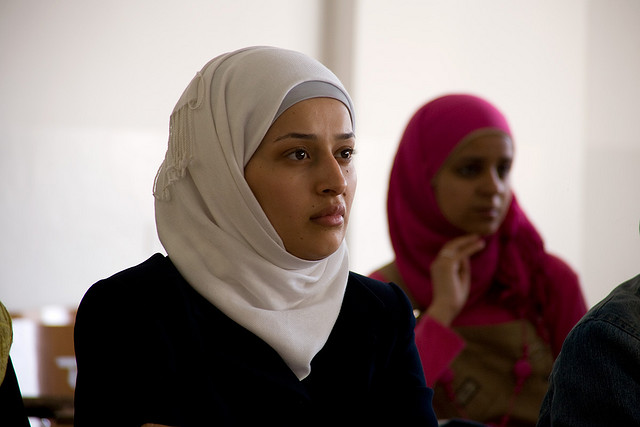The World Post at The Huffington Post, October 19, 2015
It’s Friday morning and East Jerusalem is on lockdown, the city’s Palestinian neighborhoods cut off by new, hastily erected checkpoints — massive cement blocks manned by Israeli soldiers.
In Tel Aviv, however, it’s the beginning of the weekend, and it feels like it. The streets are full of life as Israelis sit in sidewalk cafes, lingering over breakfast, as they shuffle towards the beach, or head to the shuk, the open-air market. I’m going through the motions myself, running a couple of errands before the Sabbath begins.
But as I move freely through Tel Aviv, I can’t stop thinking about East Jerusalem. A majority of those who have attempted or have carried out recent attacks on Jewish Israelis have come from the Palestinian neighborhoods of East Jerusalem. Indeed, some journalists and commentators are pointing to the area as the epicenter of the current unrest, or intifada, call it what you will.
East Jerusalem is a place I know well. As a journalist, I wrote about the housing shortages and inequalities that plague the area due to Israeli policy. I also taught at a Palestinian university in Abu Dis, a Jerusalem neighborhood on the “other” side of the separation barrier that I lived in for some time, as well.
When I think about East Jerusalem now, however, I think less about my own experience and more about my former students, who came from there and the West Bank. They were 17, 18, 19-years-old. Freshmen in college. They were not unlike the university students I’d taught in the United States. Some were hardworking and devoted to their studies; others came to class unprepared and full of excuses. All worried about their grades.
In short, they were normal kids who wanted normal lives.
They wanted to come to college without having to pass through Israeli checkpoints. They wanted to return home and find all of their family members present, that none of their fathers or brothers had been taken to administrative detention (imprisonment without trial). They wanted to sleep through the night without the fear of soldiers raiding their house, turning it upside down, or stationing themselves on the roof — events a number of my students described in their essays.
They wanted their younger brothers and sisters to be able to go to school, something that isn’t always possible in East Jerusalem. The West Bankers among them wanted to be able to visit Jerusalem without a permit. Those who lived in East Jerusalemwanted neighborhoods where the garbage had been collected, places where the police helped keep law and order, where they could feel safe, where there was decent infrastructure, where they could get permits to build houses or add on to existing structures. Where their homes would not be demolished.
All of my students wanted to graduate and find decent jobs, something increasingly difficult to do in both East Jerusalem and the West Bank, where the economies have been de-developed by the Israeli occupation and where unemployment is rampant. They wanted to marry one day and start families of their own.
My students wanted what any human being wants, regardless of nationality.
Whether they hailed from the West Bank, where the Palestinian Authority has control over designated areas, or East Jerusalem, where there is no PA presence and where Israel shirks its responsibility towards Arab residents, my students had little faith in the Palestinian leadership to help them out.
During the 2012 Operation Pillar of Defense — which claimed six Israeli lives and saw more than 100 Palestinian casualties — my students convened a town hall meeting to discuss the events and strategies for protesting Israel’s bombardment of Gaza. They openly expressed their frustration with all Palestinian political parties, including Fatah, which leads the PA. They called not for the resurrection of the largely defunct parties like the Popular Front for the Liberation of Palestine but for something completely new, something from the ground up.
Fast forward to today’s protests and stabbings. The latter are cries of despair and hopelessness, tragic suicide missions that are unlikely to accomplish much of anything besides more needless bloodshed.
Foreign analysts have been quick to claim that recent events are about Al Aqsa, and they’ve been even quicker to argue about whether or not this is a third intifada. But both discussions miss the point.
Yes, Israeli provocations at Al Aqsa were a proverbial match. But the tinder is the occupation and the many forms of violence — literal and structural — that Palestinians experience at Israel’s hands every day. And because Al Aqsa is in Israeli-occupied territory, it can be understood as both a religious and political symbol.
Those who call this a religious war, and who point to Abbas’ words as incitement, have got it backwards. Abbas — whose term expired in 2009 and has little legitimacy on the Palestinian street — is trying to insert himself into recent events in a bid to regain popularity.
But the Palestinian youth who are protesting and carrying out attacks on Israelis care little what he or other politicians say. Indeed, their actions can also be understood as moves against the current state of politics, including the Palestinian Authority itself. The young people are calling for something new, for something more than endless negotiations that go nowhere or that buy Israel the time to build more settlements and deepen the occupation. After all, this is the generation that was born and raised after the Oslo Accords were signed in 1993 — their difficult lives are a testimony to what negotiations will get the Palestinian people. That is to say, little.
The youth are calling for their human and civil rights, for equality, for hope. Will Israel — and the world — listen?
